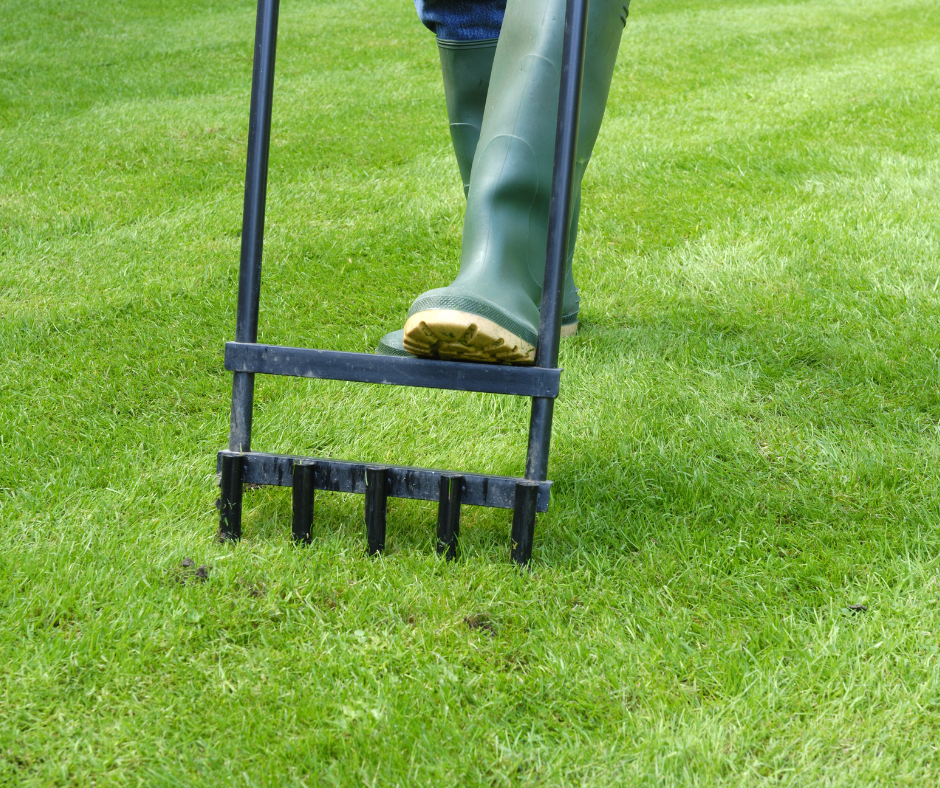Different Ways to Aerify your Lawn

We have all heard the term aerify and it seems that it is a term that gives a generic representation of a multitude of processes. Each having their own specific purpose and benefit to your lawn. Some can be done by you while some should be done by a professional. The act of aerify is simply to relieve compaction of a soil and to facilitate air exchange between the atmosphere and the soil. Good air in and bad air out. So, what are they and how do could they benefit your lawn?
Deep Tining

This is the process of creating aeration holes that are 6 to 12 inches deep with either solid or hollow tines. Tines are normally between 0.75 to 1.25 in diameter. Deep tining machines help fracture the soil, creating a more open structure. A kick can be added to the tine once at its full depth in the ground. Meaning that it can create a scoop like void at the bottom of the hole that heaves the soil to facilitate the creation of an open structure.
Deep tining is fundamental in creating a deep root structure. Root will travel down the holes created, searching for water and nutrients. If you have a perched water table or soil layer in your lawn, this machine can be used penetrate the layer. Maybe your local friendly Golf Course Superintendent could help you out with this one as a side job as nearly all golf courses have one.
Core Tining

This involves the removal of a soil plug to a max depth of 6 inches. Compaction and thatch are reduced through this method, and this is the most common aeration practice used by landscape companies. Thatch reduction is only achieved with this method if the plugs are picked up! So, make sure you verify this before hiring. Try to do this when soil is moist as it aids in tine penetration. Core tining can be done by pulling a cylindrical drum with coring tines installed on it or with a power-driven unit that is available at most hardware/landscape stores and is rented out for around $100 a day.
Solid Tining

Pretty much the same as Core tining, just with a solid tine, Tines can be for 1/4 inch in diameter all the way up to 3/4 inch. Solid tining is done to relieve hydrophobic conditions in the top layer of soil, to ensure water penetration into the soil during warm dry times. Creating channels for water to move into in heavier soils is crucial for grass plant to survive. Relieving compaction in the upper rootzone is the other reason for solid tining. The fractures as it penetrates, leaving a void where roots can enter, and gasses can be exchanged. Ideal to be done on heavy traffic areas. Can be done by hand with a pitchfork, push roller with tines attached, pulled with a cylindrical drum or rented from your local landscape store.
Slitting/Spiking

This is a similar method to solid tining and is done for the same reasons with the exception that slitting can cut horizontal grass stems. Horizontal stems block light to underlying grass which results in bare patches and a thinner sward. Slitting aids with aeration, compaction reduction and improving density over the long term. Most slitters are ground driven weighted knives set on a roller. this process is super easy and extremely beneficial to your lawn. If you have extra time in the week it’s always fun to drive around with one of these. Cost is relatively cheap at around $200.
Vertiquake

This is on the extreme end of fixing a compacted soil and involves a series of thin sharp plows set into the ground with a specific quake machine and pulled through the ground while the machine shakes the knives. Vibration into the soil fractures the structure to increase air and capillary spaces. If you can get your lawn to loosen up and you’re holding water after rain events even though you have been aerating, this might be the next option for you. Minimal surface disruption.
Scarifying

This is a similar process to verticutting but must be done when grass can actively recover. Scarifying is a deeper verticut into the thatch layer and removes some dirt with the thatch. Benefit of this is you are opening up that thatch layer and reducing the chance of impermeable soil surface. Lots and lots of debris is removed from this and due to this process, you are encouraging your plant to tiller out and increase density. Any horizontal stems will be cut, and decaying matter will be removed. Very aggressive process so make sure your grass is healthy and is receiving regular fertilizer treatments.
All of these methods can be used to obtain a healthy lawn. Some can easily be done by yourself, and judgments will need to be made on how much organic matter/thatch you have to determine the frequency. Slitting can be done anytime and as offer as you want. It helps spring and fall creating slits for roots to develop into and in summer it ensures water entrance into your soil. If you have any questions on what might be good for you, leave a comment.
Related Posts
5 Key Practices for a Healthy Lawn
I know that taking on your lawn can be a fun but daunting process. So …
March 13, 2023Annual Lawn Care Program for Warm Season Grasses
Developing an annual plan is critical to the success of a healthy lawn. This program …
February 25, 2023© 2023 LaPageBrands, LLC. All rights reserved.



